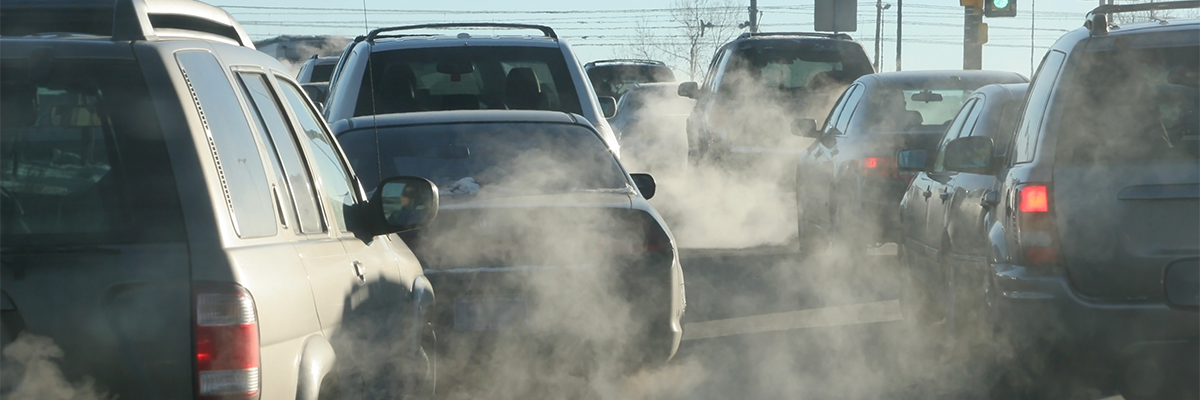
Behavioral Economics Explains Our Addiction To Fossil Fuels—And What It Will Take To Quit.
By Hersh Shefrin
Santa Clara University behavioral economics Professor Hersh Shefrin realizes most of us have intellectually accepted the obvious and rational answer to global warming: Wind down our addictions to fossil fuels in order to reduce the harmful carbon dioxide they release into our atmosphere.
But after four decades of teaching and writing about his field, Shefrin knows how our emotions can interfere with our ability to act rationally. So we continue to make irrational economic decisions—believing we’ll get lucky and the problem will solve itself, for example—even if it means ignoring the havoc that climate change already is wreaking on life on Earth.
“We’re hoping that alternative energy, carbon dioxide removal, and technology generally is going to solve the problem because we haven't been able to deal with our own lack of willpower in terms of consuming less of the things that are most problematic, like products derived from burning fossil fuels,” says Shefrin.
In his new book, “The Behavioral Economics and Politics of Global Warming: Unsettling Behaviors,” he explores the reasons behind our inaction and reasonable answers that he believes are within our grasp. As Professor Shefrin says, “The reason I wrote this book is because we need to understand what’s leading us to make irrational decisions whose consequences involve enormous risks for the future survival of humanity.”
As world leaders gathered this month in Dubai for the annual U.N. Climate Change Conference, we sat down with the professor to talk about the highlights of his book and his prescriptions for a better global future.
You contend that society is addicted to fossil fuels. What do you mean by that?
Burning fossil fuels is to consumers what ingesting alcohol is to problem drinkers—too much of a good thing: tempting with immediate benefits, even knowing that there will be a significant price to pay in the future for overconsuming today.
Many problem drinkers know they have a problem. They get to the point where they say, “I can't do this by myself. I need help, and I will join Alcoholics Anonymous to help me to change my behavior.” So even though in theory they know what needs to be done to avoid being a truly problem drinker, only by turning to an A.A. programmatic Twelve-Step approach can they finally take the steps needed to confront their addiction.
Much like drinkers know they need A.A. but avoid it, manufacturers know they can't make lasting change without making it financially advantageous to move away from fossil fuels. That's why carbon tax is so important; it's the A.A. of climate change, correct?
Right! For decades, economists have applied the theory of externalities to urge policymakers to reduce carbon dioxide emissions by using taxes to price carbon at its social cost. We are all familiar with the fact that products with costly ingredients tend to be more expensive; and we tend to cut down our purchases of expensive products.
If we recognize and treat carbon dioxide emissions like an ingredient for a product, then we can make the product more expensive by taxing the carbon. That will induce people to cut down their purchases of carbon-intensive products, and lower emissions.
If we impose a tax on carbon, we can then use the revenue to invest in technology that will reduce future emissions or adapt to climate change.
Resisting the imposition of sensible fees on greenhouse gas emissions is akin to resisting rehab, to resisting A.A. Both stem from psychological pitfalls such as denial, a lack of self-control, cognitive dissonance, and frankly, ignorance.
The costs of these pitfalls are enormous and have forced us to over-rely on technology, and to trust luck that technology will save us from severe climate damage. There is hope in technology, but because of the reluctance to price carbon at its social cost, the outcomes will be much more expensive than necessary.
Unlike A.A., where a person has to commit to sobriety, you don’t believe we have to go cold turkey with fossil fuels—at least not right away. Why do you think that approach would be successful?
Of course there's no guarantee this would be successful, but I think it's our best option. Also, the stakes are so high, we need to try.
Economists call the approach a “climate-policy ramp,” where we begin with a low carbon tax, so people can get used to it, and ramp up over time. This is what Canada does, and it would be good for the rest of the world to follow its lead.
There is a series of psychological principles that apply here. Some relate to a behavioral program called “Save More Tomorrow” which helps people to overcome self-control problems about not saving enough for retirement. The analogue to global warming of SMT is called “Green More Tomorrow.” The first step of GMT is to establish the program as a default, and this means instituting a carbon tax with a carbon-policy ramp.
Beyond the mechanics, we need people to change their mindsets. We understand that if we lease an apartment or buy a house, we need to pay more if we want higher quality. If we are only willing to pay for substandard, that is what we will get—substandard accommodation.
Well, we are leasing the planet and if we want a higher quality planet, we need to have a mindset of paying for higher quality. Otherwise we will end up living on a substandard planet with rising temperatures, more intense wildfires, more droughts, more famines, rising sea levels, increased and severe flooding, and other climate damage.
We pay for higher quality by instituting carbon taxes that reduce carbon dioxide emissions and generate revenue to fund abatement and adaptation.
An example close to home of adaptation is SFO. The average ground elevation above sea level at the San Francisco International Airport is between 10 feet and 20 feet. Eventually, the runways will be underwater, if we don’t do something. We will need to be taxed to fix the problem, and the estimated tab for just the airport is over half a billion dollars. More broadly, the estimated bill for addressing sea level rise in the Bay is more than $100 billion.
You’re saying that we need to change our climate mindsets so that we stop thinking of carbon taxes and higher prices for carbon intensive products only as deadweight losses?
Exactly. That is part of “carbon A.A.” which stands for “carbon-addiction anonymous.” We need C.A.A and we need it badly.
Let’s talk numbers. The Trump administration, no friend of addressing global warming, used a carbon dioxide price of $5 per ton. Today, the Environmental Protection Agency uses a price at $190 a ton. But there’s no carbon tax in place. If we started slow, say at $35 a ton, then the impact on consumers would be about a 10 percent increase in the price of gas and a 25 percent increase in the price of electricity.
That is manageable. But the country is addicted to low gas prices. You could see this addiction last year when inflation surged and President Biden came under pressure to do something to lower prices at the pump. If we were smart, we would welcome higher prices at the pump.
This is a global issue. We should be marching in Washington D.C. and in Beijing and in all the capitals of Europe, with placards that say, “Carbon Tax Us Now!”
You remind readers that the U.S. altered its addiction to fossil fuels before, during the Arab oil embargo of 1973, when the price of a barrel of oil quadrupled. It taught us to be more energy efficient—for a while. Then we fell off the wagon, and reverted to irrational thinking?
The gas price hikes in the 1970s made such an impact on Americans that they started to buy smaller cars. They changed their lifestyles so they would wind up purchasing less gas.
We need a repeat of that 1970s experience now, with a carbon tax acting as the driver to boost the prices of all fossil fuel intensive products.
Unfortunately, Americans don't like compact cars. All else being equal, they prefer big cars, like SUVs. That is why the country responded to the high gas prices of the 1970s by investing and subsidizing fossil fuels.
Yes, we actually subsidize the burning of fossil fuels, which is akin to reducing the price of alcohol for problem drinkers. Remember, we do not live in a rational world.
What drives our irrational tendency to believe that we can count on luck in our approach to reducing the world’s CO2 levels?
Evolution has led us to survive by taking chances when we are behind the eight ball, because some of us will be lucky, and survive. Natural selection. Now that we see that global warming is a real threat, we realize that we're behind the eight ball. And it’s bringing out our hereditary inclination for risk-taking, which in this context is to bet that technology will save us.
What are the implications of all of this for our campus?
Four things, I think, to augment what we are already doing at Santa Clara:
- Recognize the true social cost of carbon, and build it into our University’s decision systems.
- Educate everyone about the importance of pricing carbon at its social cost and challenge special interests that argue otherwise.
- Foster Centers of Excellence whose missions combine sustainability, technological innovation, and entrepreneurship.
- Reflect on “Laudato Si'“ which states: “We urgently need a humanism capable of bringing together the different fields of knowledge, including economics, in the service of a more integral and integrating vision.” And then read pertinent Biblical passages such as Exodus, Chapter 22, verses 4 and 5 about the commandment to price externalities at their social costs. Next read Genesis, Chapters 6 and 7, the story of Noah, about flood damage and sea level rise. In particular, reflect on what verses 5, 6, and 7 of Genesis Chapter 6 suggest about human nature. Connect the dots…
Photo courtesy of iStock.

